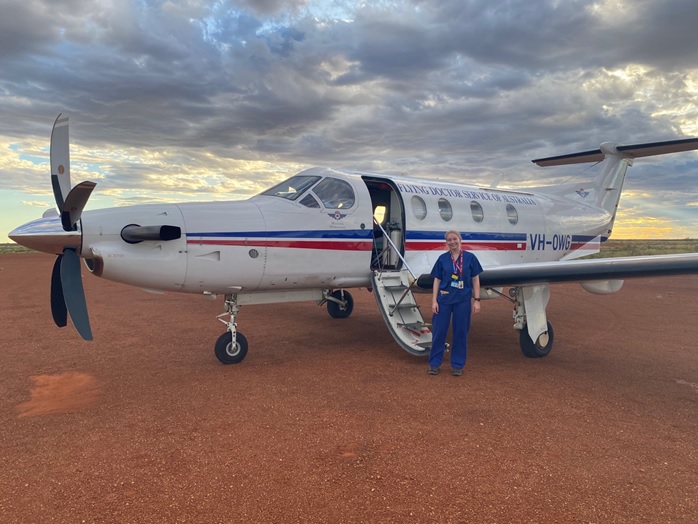Anaesthesia with the Royal Flying Doctor Service in Western Australia – Laura Appleton, King’s College London, 2023
For my elective I was lucky to spend four weeks in remote Western Australia with the Royal Flying Doctor Service, followed by three weeks at the Royal Melbourne Hospital’s anaesthetics department.
During my time with RFDS, I was able to gain experience in fundamental principles of anaesthetics. An RFDS doctor provided excellent airway skills teaching whilst on base, and teaching on Rapid Sequence Induction in the pre-hospital setting. Crucially, I was able to use the teaching airway mannequins and a video laryngoscope to practice the technique of endotracheal tube intubation. Having only witnessed this previously, practicing hand positioning and movement required was a beneficial learning experience.
This was followed by a valuable experience, where I joined a priority 1 flight for a primary retrieval to the outback. The patient was very sick, with a systolic blood pressure of 49, and with a vague history. The doctor and flight nurse had discussed action plans for various possibilities prior to arrival, with intubation being a last resort. Meteraminol and noradrenaline were given to try to stabilise the patient’s blood pressure and pulse.
However, once in-flight, the patient deteriorated, and became extremely agitated. It was decided the patient needed to be intubated, as he was unstable. I was responsible for preparing midazolam, morphine, and ketamine, with propofol and rocuronium already drawn up pre-flight in case of emergencies. An RSI was subsequently performed, with the intubation being unsuccessful on first attempt, but thankfully successful on a second go.
This was an intense three hours flying to Perth, the closest tertiary centre for definitive care, with constant action required for the duration. Having only seen two ET intubations in elective surgeries in large teaching hospitals before, being able to see, and have some degree of involvement in, an RSI and in-flight intubation, was one of the most memorable aspects of my elective. Furthermore, this was one of the first experiences I have had of being in high stress environment with a patient in a critical condition. I was able to see the dynamics and team-working between the doctor, flight nurse and pilot to optimise the patient’s outcome whilst ensuring safety.

For the second half of my elective, at the Royal Melbourne Hospital I was able to join anaesthetists on a range of lists, ranging from lengthy thoracic lists, to general surgery, to shorter procedures such as abscess drainage. Whilst at the RMH, I was able to perform the pre-oxygenation and bagging of most patients, and became confident with head tilt chin lifts and jaw thrusts. I was glad to gain practical skills, inserting a number of laryngeal mask airways and two endotracheal tube intubations, with assistance. Moreover, with more time here than my previous limited 4th year anaesthetic placement, I was able to gain a better understanding of the ventilator settings, and modes of ventilation.
Moreover, this part of my elective developed my understanding of the drugs involved in anaesthetics, being able to discuss when to use fentanyl vs remifentanil, and when to use different muscle relaxants. I was also able to appreciate anaesthetic implications for patients who are recreational drugs users. Finally, I was able to develop an appreciation for different monitoring methods, such as the BIS and TOF %, whilst further appreciating the patient’s vital signs as parameters of pain and distress, and anaesthetic drug induced changes.
I would like to thank the Association of Anaesthetists for award the of £300, of which I am very grateful for and which helped facilitate my elective.